Li-Pos: A Light Positioning Framework Leveraging OFDM for Visible Light Communication
Abstract
:1. Introduction
2. System Configuration Methodology
2.1. VLC Principle and System Model
2.2. Motivation and Observation
2.3. Channel Estimation
2.4. Distance Estimation
3. Result and Discussion
4. Conclusions
Author Contributions
Funding
Institutional Review Board Statement
Informed Consent Statement
Data Availability Statement
Conflicts of Interest
Appendix A
The Proof of Proposition 1
References
- Lan, H.Y.; Tseng, I.C.; Lin, Y.H.; Lin, G.R.; Huang, D.W.; Wu, C.H. High-speed integrated micro-LED array for visible light communication. Opt. Lett. 2020, 45, 2203–2206. [Google Scholar] [CrossRef] [PubMed]
- Tsai, C.T.; Cheng, C.H.; Kuo, H.C.; Lin, G.R. Toward high-speed visible laser lighting based optical wireless communications. Prog. Quantum Electron. 2019, 67, 100225. [Google Scholar] [CrossRef]
- Arshad, J.; Rehman, A.; Rehman, A.U.; Ullah, R.; Hwang, S.O. Spectral efficiency augmentation in uplink massive MIMO systems by increasing transmit power and uniform linear array gain. Sensors 2020, 20, 4982. [Google Scholar] [CrossRef]
- Asif, R.M.; Arshad, J.; Shakir, M.; Noman, S.M.; Rehman, A.U. Energy Efficiency Augmentation in Massive MIMO Systems through Linear Precoding Schemes and Power Consumption Modeling. Wirel. Commun. Mob. Comput. 2020, 2020, 8839088. [Google Scholar] [CrossRef]
- Haider, S.A.; Adil, M.N.; Zhao, M. Optimization of secure wireless communications for IoT networks in the presence of eavesdroppers. Comput. Commun. 2020, 154, 119–128. [Google Scholar] [CrossRef]
- Rudić, B.; Klaffenböck, M.A.; Pichler-Scheder, M.; Efrosinin, D.; Kastl, C. Geometry-Aided BLE-Based Smartphone Positioning for Indoor Location-Based Services. In Proceedings of the 2020 IEEE MTT-S International Conference on Microwaves for Intelligent Mobility (ICMIM), Linz, Austria, 23 November 2020; pp. 1–4. [Google Scholar]
- Chen, S.; Guan, W. High accuracy VLP based on image sensor using error calibration method. arXiv 2020, arXiv:2010.00529. [Google Scholar]
- Jung, H.; Kim, S.M. A Full-Duplex LED-to-LED Visible Light Communication System. Electronics 2020, 9, 1713. [Google Scholar] [CrossRef]
- Hou, Y.; Xiao, S.; Zheng, H.; Hu, W. Multiple access scheme based on block encoding time division multiplexing in an indoor positioning system using visible light. J. Opt. Commun. Netw. 2015, 7, 489–495. [Google Scholar] [CrossRef]
- Oliveira, H.M.; da Fonseca, N.L. Routing, spectrum and core assignment algorithms for protection of space division multiplexing elastic optical networks. J. Netw. Comput. Appl. 2019, 128, 78–89. [Google Scholar] [CrossRef]
- Chi, Y.C.; Hsieh, D.H.; Tsai, C.T.; Chen, H.Y.; Kuo, H.C.; Lin, G.R. 450-nm GaN laser diode enables high-speed visible light communication with 9-Gbps QAM-OFDM. Opt. Express 2015, 23, 13051–13059. [Google Scholar] [CrossRef] [Green Version]
- Wu, T.C.; Chi, Y.C.; Wang, H.Y.; Tsai, C.T.; Huang, Y.F.; Lin, G.R. Tricolor R/G/B laser diode based eye-safe white lighting communication beyond 8 Gbit/s. Sci. Rep. 2017, 7, 1–10. [Google Scholar] [CrossRef] [Green Version]
- Du, C.; Peng, B.; Zhang, Z.; Xue, W.; Guan, M. KF-KNN: Low-Cost and High-Accurate FM-Based Indoor Localization Model via Fingerprint Technology. IEEE Access 2020, 8, 197523–197531. [Google Scholar] [CrossRef]
- Lian, J.; Vatansever, Z.; Noshad, M.; Brandt-Pearce, M. Indoor visible light communications, networking, and applications. J. Phys. Photonics 2019, 1, 012001. [Google Scholar] [CrossRef] [Green Version]
- Irshad, M.; Liu, W.; Wang, L.; Shah, S.B.H.; Sohail, M.N.; Uba, M.M. Li-local: Green communication modulations for indoor localization. In Proceedings of the 2nd International Conference on Future Networks and Distributed Systems, Amman, Jordan, 26–27 June 2018; pp. 1–6. [Google Scholar]
- Pesek, P.; Zvanovec, S.; Chvojka, P.; Ghassemlooy, Z.; Nor, N.A.M.; Tabeshmehr, P. Experimental validation of indoor relay-assisted visible light communications for a last-meter access network. Opt. Commun. 2019, 451, 319–322. [Google Scholar] [CrossRef]
- Irshad, M.; Liu, W.; Wang, L.; Khalil, M.U.R. Cogent Machine Learning Algorithm for Indoor and Underwater Localization Using Visible Light Spectrum. Wirel. Pers. Commun. 2019, 1–16. [Google Scholar] [CrossRef]
- Bilal, M.M.; Bi, W.; Jaleel, F.; Luwen, Y.; Sohail, M.N.; Irshad, M.; Wa, J.; Madni, H.A. Magnetic fluid-based photonic crystal fiber for temperature sensing. Opt. Eng. 2019, 58, 072008. [Google Scholar] [CrossRef]
- Irshad, M.; Liu, W.; Arshad, J.; Sohail, M.N.; Murthy, A.; Khokhar, M.; Uba, M.M. A Novel Localization Technique Using Luminous Flux. Appl. Sci. 2019, 9, 5027. [Google Scholar] [CrossRef] [Green Version]
- Armstrong, J.; Schmidt, B.J. Comparison of asymmetrically clipped optical OFDM and DC-biased optical OFDM in AWGN. IEEE Commun. Lett. 2008, 12, 343–345. [Google Scholar] [CrossRef]
- Zhang, X.; Zhou, Y.F.; Yu, Y.P.; Han, P.C.; Wang, X.R. Comparison and Analysis of DCO-OFDM, ACO-OFDM and ADO-OFDM in IM/DD Systems. In Applied Mechanics and Materials; Trans Tech Publications Ltd.: Stafa-Zurich, Switzerland, 2015; Volume 701, pp. 1059–1062. [Google Scholar]
- Ghimire, B.; Seitz, J.; Mutschler, C. Indoor Positioning Using OFDM-Based Visible Light Communication System. In Proceedings of the 2018 International Conference on Indoor Positioning and Indoor Navigation (IPIN), Nantes, France, 24–27 September 2018; pp. 1–8. [Google Scholar]
- Gu, W.; Aminikashani, M.; Deng, P.; Kavehrad, M. Impact of multipath reflections on the performance of indoor visible light positioning systems. J. Light. Technol. 2016, 34, 2578–2587. [Google Scholar] [CrossRef] [Green Version]
- Lin, B.; Tang, X.; Ghassemlooy, Z.; Lin, C.; Li, Y. Experimental demonstration of an indoor VLC positioning system based on OFDMA. IEEE Photonics J. 2017, 9, 1–9. [Google Scholar] [CrossRef]
- Dawood, M.A.; Saleh, S.S.; El-Badawy, E.S.A.; Aly, M.H. A comparative analysis of localization algorithms for visible light communication. Opt. Quantum Electron. 2021, 53, 1–25. [Google Scholar] [CrossRef]
- Zhang, W.; Chowdhury, M.S.; Kavehrad, M. Asynchronous indoor positioning system based on visible light communications. Opt. Eng. 2014, 53, 045105. [Google Scholar] [CrossRef]
- Alonso-González, I.; Sánchez-Rodríguez, D.; Ley-Bosch, C.; Quintana-Suárez, M.A. Discrete indoor three-dimensional localization system based on neural networks using visible light communication. Sensors 2018, 18, 1040. [Google Scholar] [CrossRef] [Green Version]
- Eroglu, Y.S.; Guvenc, I.; Pala, N.; Yuksel, M. AOA-based localization and tracking in multi-element VLC systems. In Proceedings of the 2015 IEEE 16th Annual Wireless and Microwave Technology Conference (WAMICON), Cocoa Beach, FL, USA, 13–15 April 2015; pp. 1–5. [Google Scholar]
- Nadeem, U.; Hassan, N.; Pasha, M.; Yuen, C. Highly accurate 3D wireless indoor positioning system using white LED lights. Electron. Lett. 2014, 50, 828–830. [Google Scholar] [CrossRef]
- Xu-Dong, W.; Xian-Ying, X.; Nan, W.; Hai-Yan, F. Dimming control technique for OFDM based indoor visible light communication system. Acta Photonica Sin. 2015, 44, 1106002. [Google Scholar] [CrossRef]
- Xu, Y.; Wang, Z.; Liu, P.; Chen, J.; Han, S.; Yu, C.; Yu, J. Accuracy analysis and improvement of visible light positioning based on VLC system using orthogonal frequency division multiple access. Opt. Express 2017, 25, 32618–32630. [Google Scholar] [CrossRef]
- Azim, A.W.; Le Guennec, Y.; Maury, G. Hermitian symmetry free optical-single-carrier frequency division multiple access for visible light communication. Opt. Commun. 2018, 415, 177–185. [Google Scholar] [CrossRef]
- Yingying, Y.; ZHANG, Z.; Liang, W.; Jian, D. Upper bounds on the capacity for optical intensity channels with AWGN. Sci. China Inf. Sci. 2017, 60, 161–172. [Google Scholar]
- Aminikashani, M.; Gu, W.; Kavehrad, M. Indoor positioning with OFDM visible light communications. In Proceedings of the 2016 13th IEEE Annual Consumer Communications & Networking Conference (CCNC), Las Vegas, NV, USA, 9–12 January 2016; pp. 505–510. [Google Scholar]
- Gu, W.; Zhang, W.; Kavehrad, M.; Feng, L. Three-dimensional light positioning algorithm with filtering techniques for indoor environments. Opt. Eng. 2014, 53, 107107. [Google Scholar] [CrossRef]
- Song, X.; Zhao, Z.; Wei, Y.; Wang, M. Research and performance analysis on multi-point light-emitting diodes-array intra-vehicle visible light communication systems with DC-biased optical–orthogonal frequency-division multiplexing. Int. J. Distrib. Sens. Netw. 2017, 13, 1550147717729785. [Google Scholar] [CrossRef]
- ds Rev, C.; Xlamp, C.; Leds, X. DRAFT Product Family Data Sheet. 2013. Available online: https://core.ac.uk/display/23382794 (accessed on 21 June 2021).
- Michael Reed, B.S. Functional Analysis; Elsevier: Amsterdam, The Netherlands, 1980. [Google Scholar]
- Wang, T.Q.; Sekercioglu, Y.A.; Neild, A.; Armstrong, J. Position accuracy of time-of-arrival based ranging using visible light with application in indoor localization systems. J. Light. Technol. 2013, 31, 3302–3308. [Google Scholar] [CrossRef]
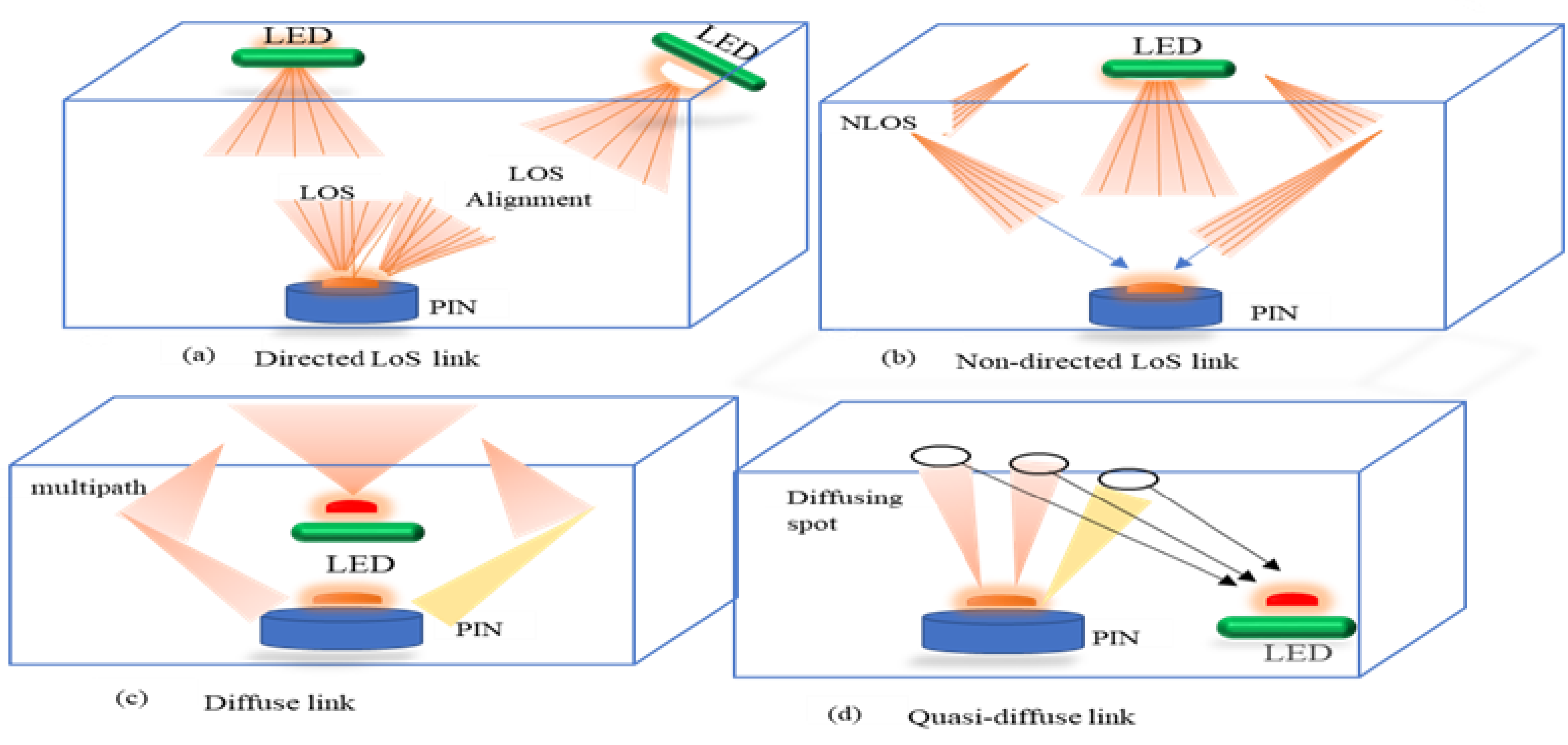
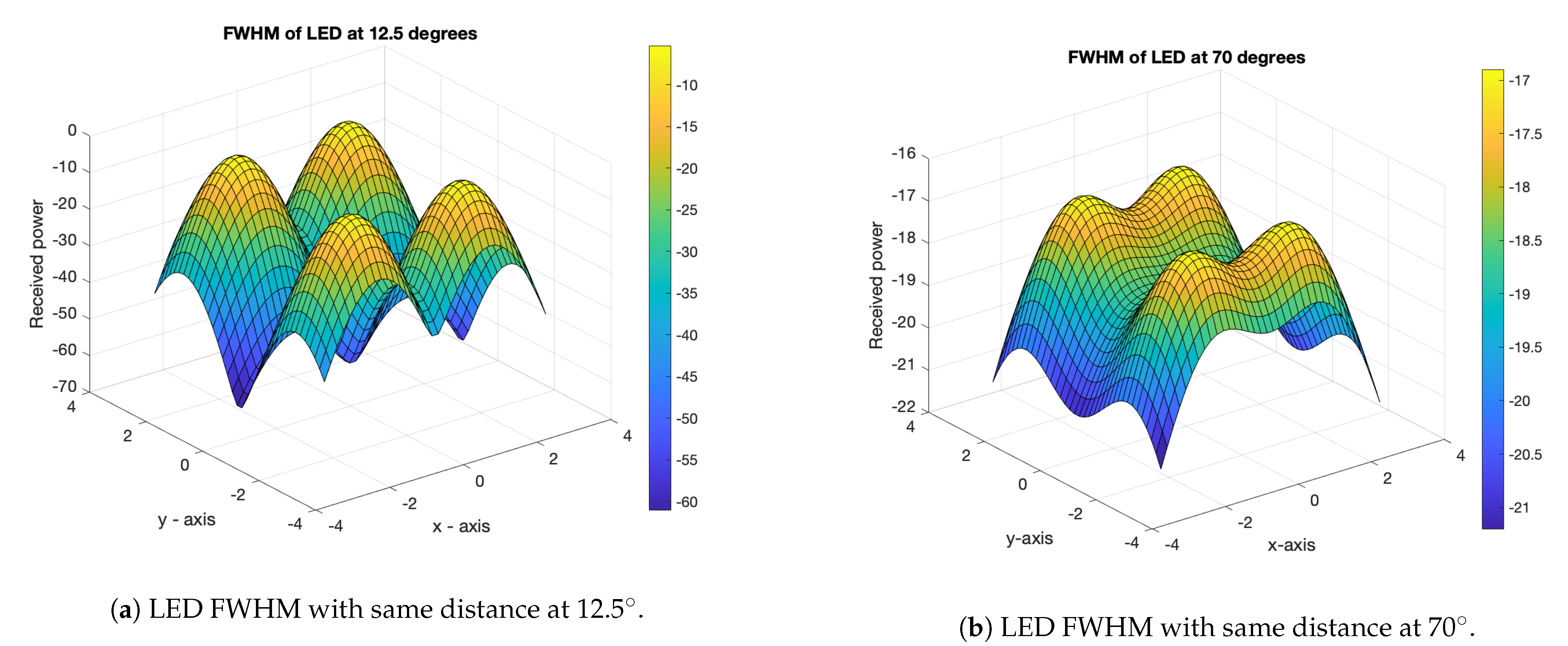
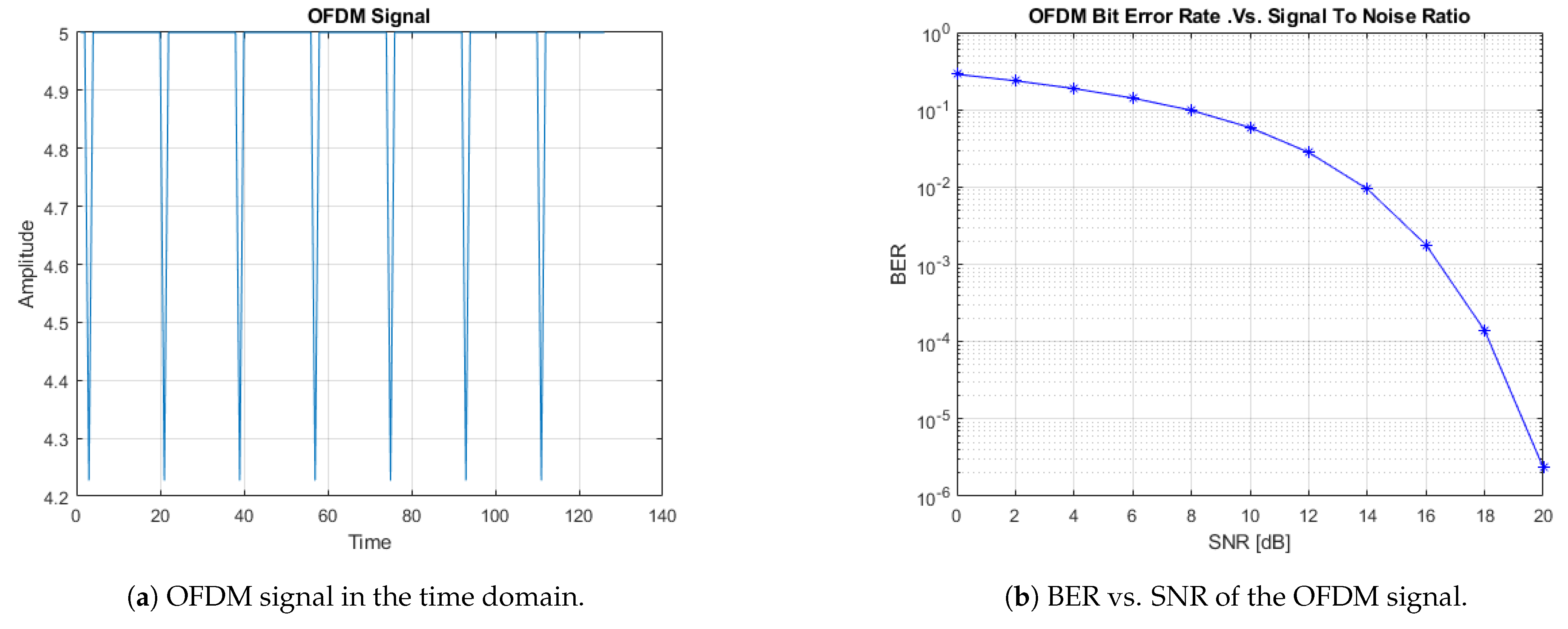
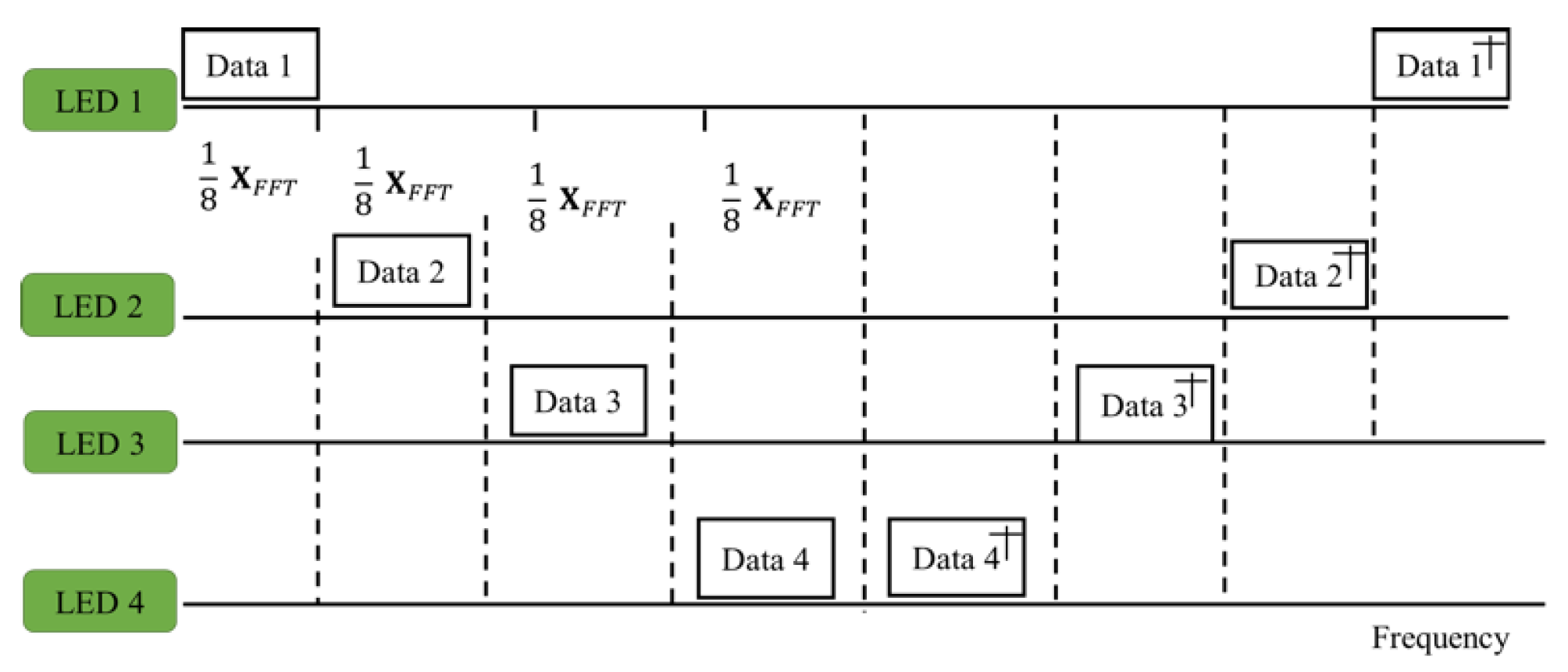
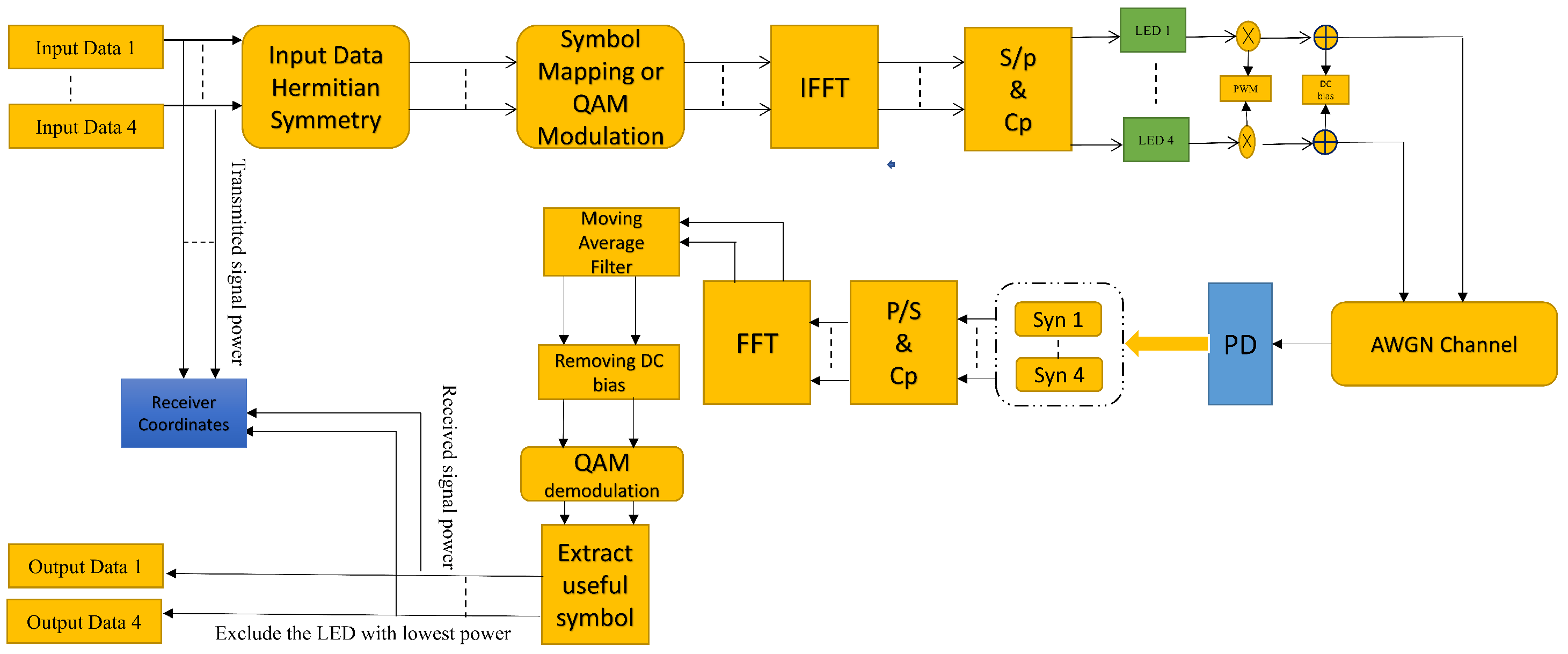
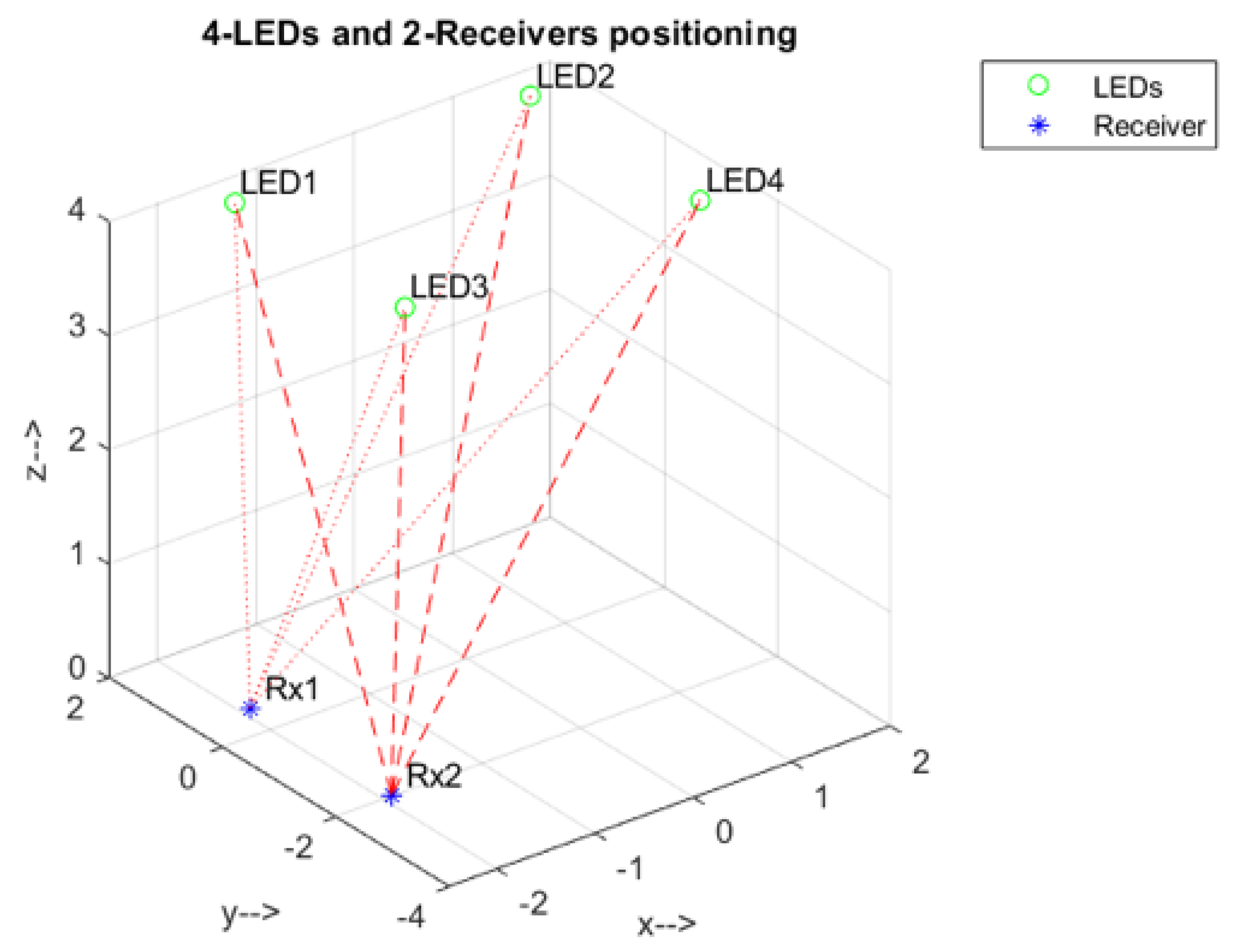

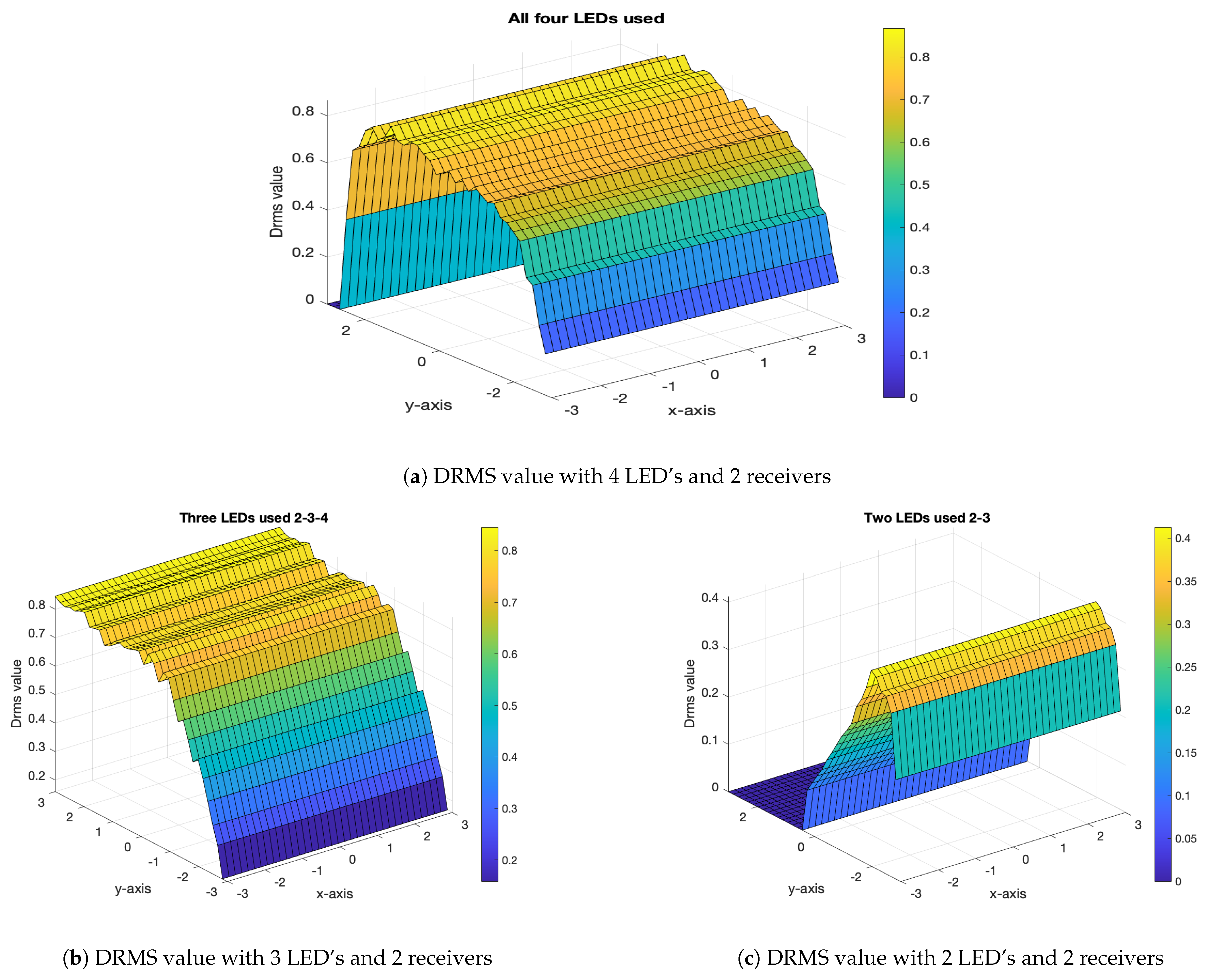
| System | Positioning Algorithm | Test Bed Size | LED Parameters |
|---|---|---|---|
| [9] | RSS triangulation | 4 LEDs, 16 W TDM | |
| [26] | RSS finger printing | 16 LEDs | |
| [27] | RSS modeling | 9 LEDs, TDM | |
| [28] | TDOA trilateration | 3 LEDs, FDM | |
| [29] | AOA triangulation | 4 LEDs, TDM | |
| Proposed work | RSS lateration | 4 LEDs, OFDM |
| Parameters | Values |
|---|---|
| Room Size | 6 m × 6 m × 4 m |
| Reflectance of ceiling | 0.35 |
| Reflectance of wall | 0.8 |
| Reflectance of floor | 0.60 |
| Coordinates of LED Source | |
| Transmitter power from the LED | 15 W |
| Half-width at half-maximum | and |
| Center luminous flux | 300 lm |
| Elevation of the LED source | |
| The azimuth of LED source | |
| Height of LED source | 2.15 m |
| Detection physical area of the receiver | 100 mm |
| Height of receiver | 0.85 m |
| Field-of-View of receiver | |
| Azimuth of receiver | |
| Elevation of receiver | |
| Spacing between receiver position | 2.5 m |
| Coordinates of first receiver | (−2.5, −0.5, 0.5) |
| Coordinates of second receiver | (−2.5, −3, 0.5) |
| Number of LEDs | Positioning | AUC (ins) |
|---|---|---|
| 4 | 1.2573 | |
| 3 | 1.7951 | |
| 2 | 1.378 |
Publisher’s Note: MDPI stays neutral with regard to jurisdictional claims in published maps and institutional affiliations. |
© 2021 by the authors. Licensee MDPI, Basel, Switzerland. This article is an open access article distributed under the terms and conditions of the Creative Commons Attribution (CC BY) license (https://creativecommons.org/licenses/by/4.0/).
Share and Cite
Wu, J.; Haider, S.A.; Irshad, M.; Arshad, J.; Noman, S.M.; Murthy, A. Li-Pos: A Light Positioning Framework Leveraging OFDM for Visible Light Communication. Sensors 2021, 21, 4310. https://doi.org/10.3390/s21134310
Wu J, Haider SA, Irshad M, Arshad J, Noman SM, Murthy A. Li-Pos: A Light Positioning Framework Leveraging OFDM for Visible Light Communication. Sensors. 2021; 21(13):4310. https://doi.org/10.3390/s21134310
Chicago/Turabian StyleWu, Jianbin, Sami Ahmed Haider, Muhammad Irshad, Jehangir Arshad, Sohail M. Noman, and Aparna Murthy. 2021. "Li-Pos: A Light Positioning Framework Leveraging OFDM for Visible Light Communication" Sensors 21, no. 13: 4310. https://doi.org/10.3390/s21134310
APA StyleWu, J., Haider, S. A., Irshad, M., Arshad, J., Noman, S. M., & Murthy, A. (2021). Li-Pos: A Light Positioning Framework Leveraging OFDM for Visible Light Communication. Sensors, 21(13), 4310. https://doi.org/10.3390/s21134310








